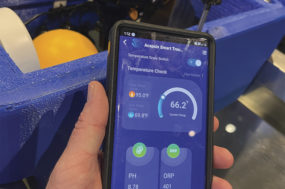On January 9, 2013, the USDA published a final rule on animal traceability. This final rule resulted from several years of the USDA’s attempt to craft regulations that would allow for effective disease monitoring and outbreak prevention, while balancing the impact on farmers and ranchers. The final rule took effect on March 11, 2013.
The final rule takes up 35 pages of the Federal Register, and as with most governmental regulations, the reading isn’t exactly light. The key aspects of the program are, thankfully, relatively straightforward. For dairy producers, compliance is achieved through two key components.
First, dairy cattle to be moved interstate must be officially identified. Second, an interstate certificate of veterinary inspection must be obtained for all animals that are moved interstate.
The final rule spells out what livestock is subject to the identification and transport regulations. For dairy producers, this is easy. “All female dairy cattle of any age and all dairy males born after March 11, 2013” are subject to official identification.
Official identification is likewise defined by the regulations. There are four methods of identifying cattle. The first is an official ear tag. The second is a registered brand, if the receiving state and shipping state agree to accept a brand inspection certificate.
The third is a tattoo or other breed registration identification. As with a brand, both the shipping and receiving state must agree to accept the registration certificate.
The final method is a group or lot identification number, which is acceptable only when a group of animals of the same species is “managed together as one group through the pre-harvest production chain.”
Identification of animals is nothing new to the dairy industry. The USDA-Animal and Plant Health Inspection Service (APHIS), the sub-agency responsible for this program, noted in its comments that accompanied the final rule that “90 percent of dairy operations use some method of identification.”
What is, perhaps, different about this particular program is the specificity of the regulations for the ear tags acceptable for use as official identification.
An official ear tag is one that is approved by APHIS and has a unique identifying number for each individual animal. Beginning on March 11, 2014, all newly manufactured ear tags must bear an official shield, which must include the U.S. Route Shield and “U.S.” or a state postal abbreviation within the shield.
The use of tags with the official shield becomes mandatory on March 11, 2015. Other than the requirements that ear tags be tamper-resistant and are sufficiently durable to remain on the animal once applied, other aspects of the ear tags will necessarily vary based upon the needs of producers and other users.
Ear tags in existing livestock need not be replaced with new ones.
The second key component of the final rule is the interstate certificate of veterinary inspection (ICVI) that must be obtained whenever covered livestock is moved between states. The ICVI will be issued by an accredited veterinarian and must include several pieces of information.
The species of animal being transported must be identified, as well as the purpose for the transport. The origin and destination addresses must also be included, along with the names and addresses of the consignor and consignee.
The identification numbers of all the animals being transported (or a state-approved document containing substantially the same information) are also required.
By its very nature, the requirement to obtain an ICVI applies only to transportation of livestock between states. Accordingly, shipment wholly within one state or shipment from one state through another state and back to the originating state does not require an ICVI.
Two other exceptions to the ICVI requirements will be of import to producers in their day-to-day operations. First, an ICVI is not required where animals “are moved directly to a recognized slaughtering establishment or directly to an approved livestock facility and then directly to a recognized slaughtering establishment and they are accompanied by an owner-shipper statement.”
The specific requirements of the owner-shipper statement are defined in the regulations and require information on origin, destination, species, number of animals and names and addresses of owners and shippers. Information regarding the identification of individual animals shipped to slaughter is specifically exempted.
In addition to the slaughter exemption, an ICVI is not required when otherwise-covered livestock is shipped across state lines for veterinary treatment and returned to the originating farm and no change in ownership occurs.
The overall costs of the traceability program are difficult to estimate, both in aggregate and on a per-operation basis. APHIS estimates the costs at $14.5 million to $34.3 million per year.
But even these estimates include some costs that can be grouped with existing management practices. These totals are for all covered cattle operations; dairy was not broken out separately. The comments to the final rule included some discussion of the per-animal costs for cattle.
But quite frankly, the discussion was not terribly meaningful or insightful. In all probability, the additional costs will be several dollars per animal when all costs are taken into account.
By necessity, this particular article contains only an overview of these regulations, which apply not only to dairy producers but to other livestock species (beef cattle, poultry, swine and deer) as well.
Each operation, depending on its structure, geographical location and management practices, will have significantly different “boots on the ground” experiences with how often and the degree to which these rules have an impact.
The final rule resulted from an obvious attempt by APHIS to consider the effect of the rule on the various livestock groups and to address different possible scenarios and concerns raised by stakeholders.
As a result, the commentary accompanying the final rule provides significant insight and guidance to the industry for compliance. The 35-plus pages of comments themselves are beyond the scope of this article, at least if it is to remain readable in terms of its length and engagement level.
But there are several resources available online that producers might find helpful for those with specific concerns or for those with a greater interest in the topic. First, the APHIS website contains a page devoted to animal disease traceability .
Among the resources is a list of questions and answers on the final rule that may answer basic questions on the new regulations and provide additional information on the purposes of the regulations.
Undoubtedly, as the entire livestock community becomes more familiar with compliance under the new regulations, additional resources and guidance should become available. PD
References omitted due to space but are available upon request. Click here to email an editor.

Ryan Miltner
Attorney
The Miltner Law Firm LLC




